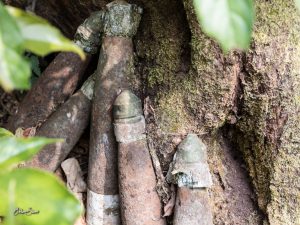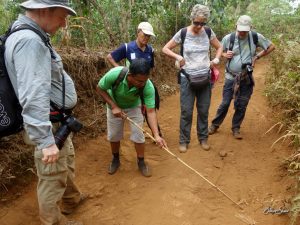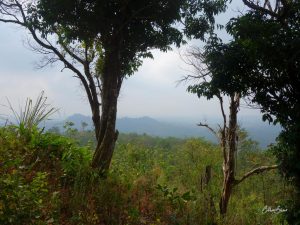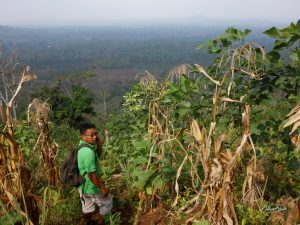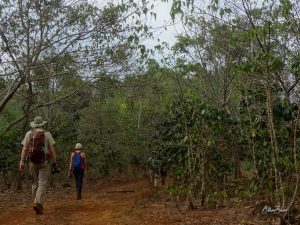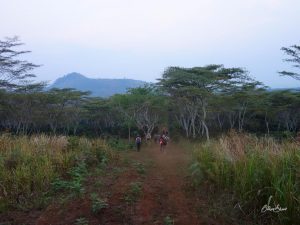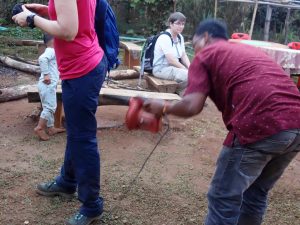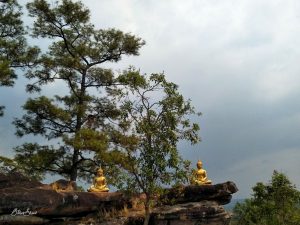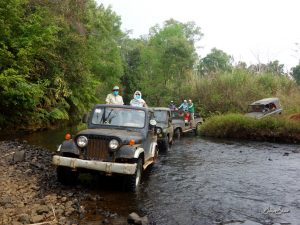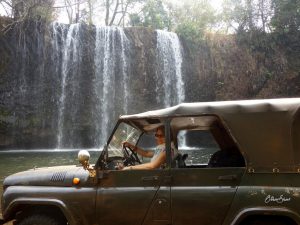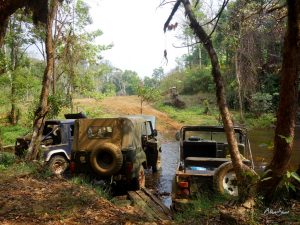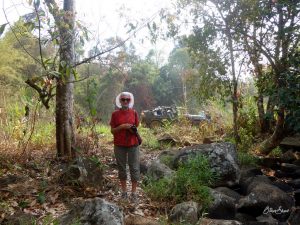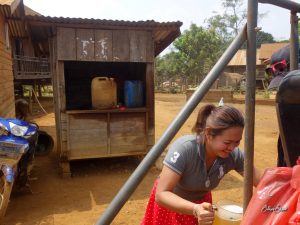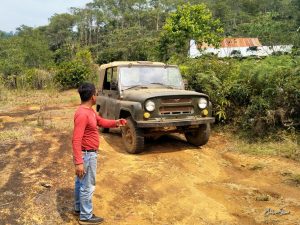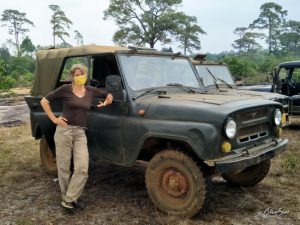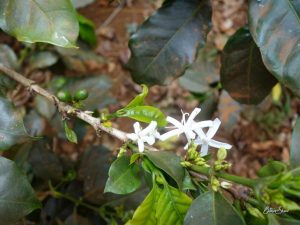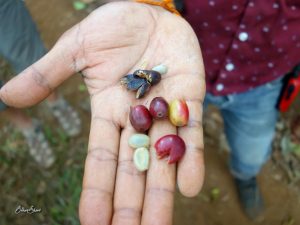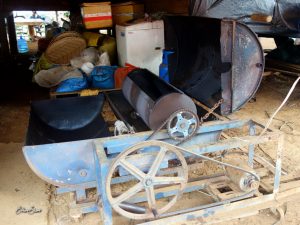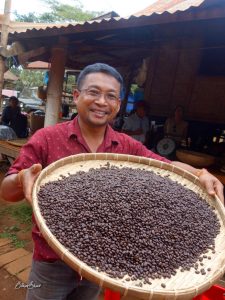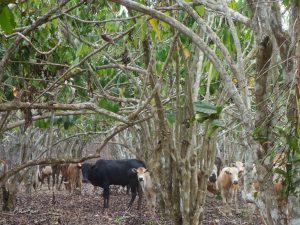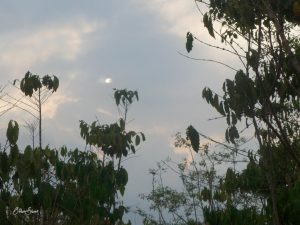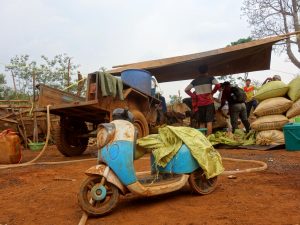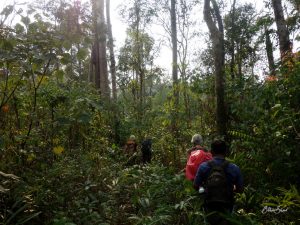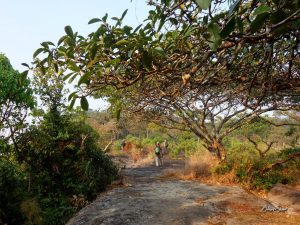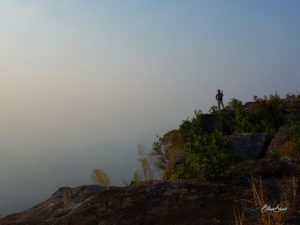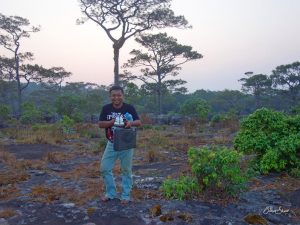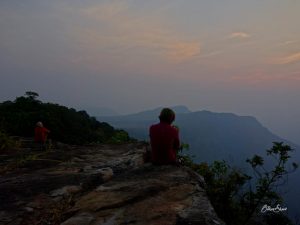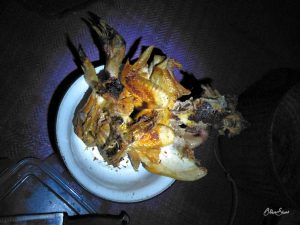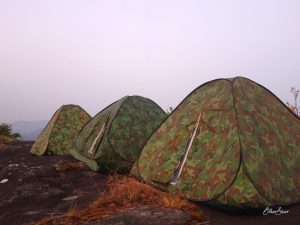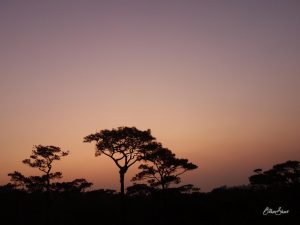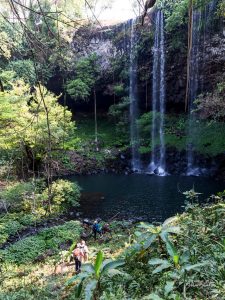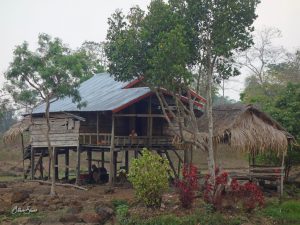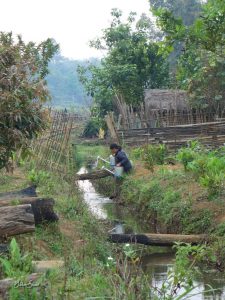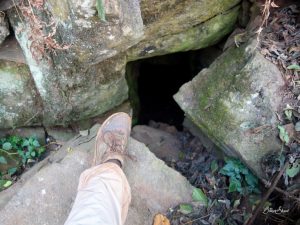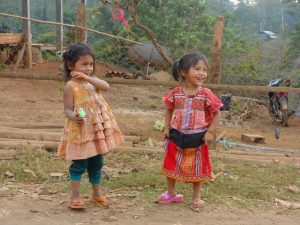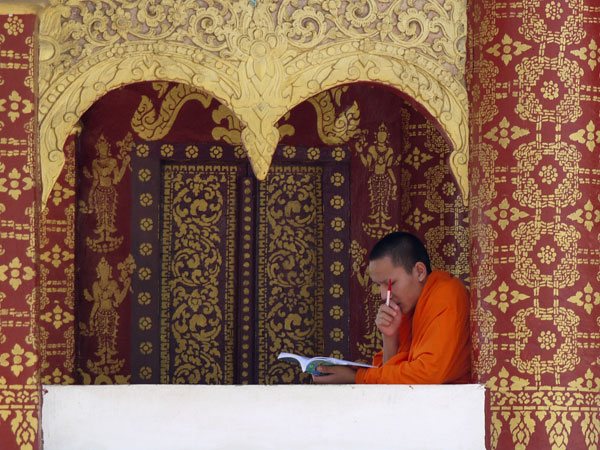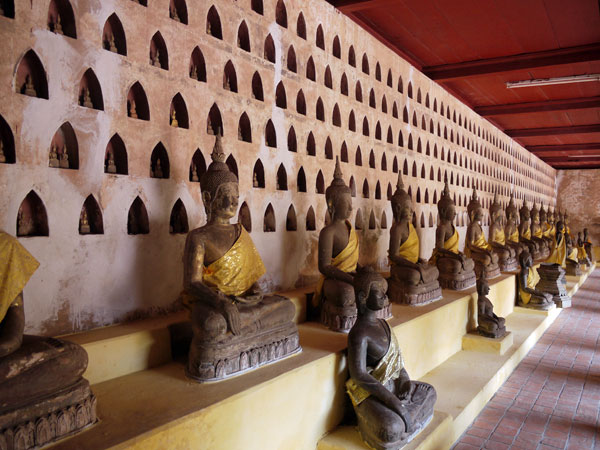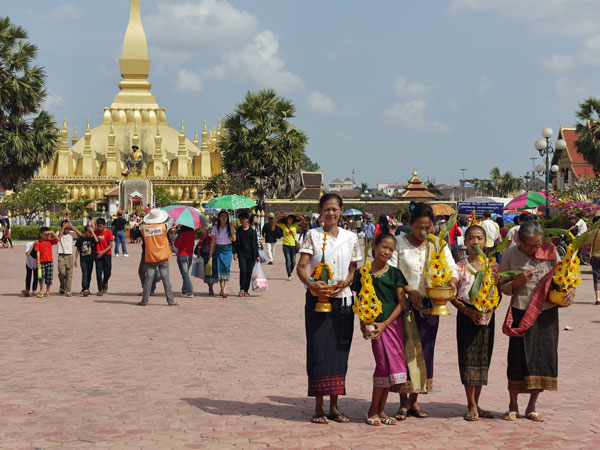
Jeep Adventure with Coffee and Bombs
“When I was a child I was playing with bombs. They had just the right size to cradle them in my arms and carry them around like a doll. They were everywhere and they were forbidden. What an attraction for a curious boy!” A pretty common childhood tale in the Laos of the late 70ies and early 80ies.
Khamsone, 42-year old jack-of-all-trades, is grinning like his former boy-self while he is taking us on a walk through what seems a lesser known war zone from the early 70ies. We are in Southern Laos, on the Bolaven Plateau to be precise, famous for a myriad of superb waterfalls, enchanting villages and due to its temperate climate, a sea of coffee.
“One day my parents told me to stay put in one place in their coffee plantation while they went out to work on the trees. Little later they came back and found me with an unexploded bomb in my hands”, he’s shrugging his shoulders. He has told the story many times. Our German minds are trying to grasp this kind of childhood. It’s not that we haven’t come across unexploded bombs in Germany, it’s just somehow not quite that ordinary.
“Very slowly my father came closer and talked me into putting it to the ground – very, very gently. ‘But why?’ I would ask, stubborn and naughty.” All the boys played with bombs at the time. “We would throw stones at them, when we discovered them in the forest”, Khamsone remembers. “Or pick them up for test of courage or sheer curiosity.”
“Oh, was my father angry with me that day, when he finally managed to make me drop the stupid thing!” I realise I have been breathing rather shallow during his story-telling. “This is the coffee plantation of my parents”, says Khamsone next. “And here are some of the bombs.”
This must be a joke? Sure, we had said we will learn about the so-called “Secret War” of the CIA in Laos as part of the tour itinerary. But this kind of history lesson is just this tiny bit too authentic for my liking. Not that I worry much about myself. You know, I’m a badass adventurer and life is anyhow short, whenever it happens it happens, etc. etc.
But as person in charge of yet another bunch of happy German tourists I feel this familiar restlessness creeping up my throat, which normally only hits when I see one of my guests exit his bicycle seat over the handle bar after his front tube exploded. Which happened earlier on the same tour, but that’s another story. Just realising some kind of over-sensitivity on my side would maybe not be all that surprising.
Mr. Khamsone is guiding us through a forest of coffee trees along a Laotian supply track of the famous Ho Chi Minh trail. The deep dirt track was dug out by the North Vietnamese Army to connect the main North-South trail to the mountain Phou Katouk near Khamsone’s home village and some other strategic positions in this particular part of the Second Indochina War (aka Vietnam War). The Vietnamese had installed a missile defence on the summit of Phou Katouk – to shoot US bombers heading for Southern Vietnam.
A lesser known part of South-East Asian history: “From 1964 to 1973, the U.S. dropped more than two million tons of ordnance on Laos during 580,000 bombing missions—equal to a planeload of bombs every 8 minutes, 24-hours a day, for 9 years – making Laos the most heavily bombed country per capita in history.” (Quote from Legacies of War)
Mind you they were officially only in war with Vietnam. Even worse: Roughly 80 million pieces of munition failed to explode and keep killing and hurting especially farmers and people on the countryside. Until today there is an estimated number of 40 new casualties from these UXO (unexploded ordnance) every year – most of them children.
“The top of this mountain is still full of unexploded bombs”, says Khamsone while we stand about one meter below the highest point. “So we won’t go there.” Cool. It’s the first time I’m not mad at my local guide that we do not fulfil the promised German itinerary which says in this case: “We will have a picnic on the top with magnificent panoramic views.”
One of my guests had asked earlier in the travels if the person who has written the tour description was on LSD. I don’t know this, but after today’s event I have an inclination to answer this question with “Yes, we always do it like that otherwise we couldn’t come up with all this unrelated travel poetry.” Well, it’s a test trip. Everyone’s here for the first time. A kind of mystery travelling you could say…
Waterfalls off the beaten path
One day earlier Khamsone had taken us in his jeeps to a set of three rarely visited waterfalls. Driving through creeks, over hills and dusty dirt tracks, quite clearly off the beaten path. “If a place is easily accessible, has a toilet and a restaurant, I’m not interested”, says the Lao business man.
And there’s only a tiny flinch in the body language of my guests when we drive past the big signs for the “most stunning waterfalls of the Bolaven Plateau”, the “Must-See-Attractions”, which are promoted with double colour pages in all the guidebooks and instead turn into some of the dustiest tracks this country has to offer.
I’m somewhat proud of them. It does need some firm self-certitude to leave out the main sights in an area which you will most likely visit only once in your lifetime. Imagine the willpower that would be required to visit Siem Reap without seeing Angkor Wat! Or stopping by Paris courageously leaving out La Tour Eifel! Or Germany missing out on the Oktoberfest!? Well…
Khamsone has been a man with a strong vision from a young age. In his early twenties he convinced his coffee farming parents to approve his idea to take private English lessons with a tutor. Jobs as a waiter and bellboy followed and soon he could pay for his next purchase of land in the Bolaven Plateau.
Over the next several years he would go on to receive his tour guide license and work during the Laos tourism boom in 2005 – 2007. He was able to buy 16 more hectares of land and in 2010 pursued his dream of starting a coffee plantation himself.
2014 he realised he needs to find a way to financially support the growth of his business and create more opportunity for his workers. This is when he decided to put together a tour program that would invite guests to his plantation, but also taking them out to the beautiful surroundings of his hometown, including waterfalls, mountain treks and historical sites.
These days tourists can sleep in the cosy homestay on his plantation, learn all things coffee from bean to cup and explore the countryside in rusty dusty jeeps.
Khamsone, now in his early 40ies, is a smart and successful business man no doubt. But he is also remarkably generous and cooperative. His latest vision is to create a community of jeep drivers and guides to help him promote country and coffee. He wants his employees and their families, the people from the villages, to partake in the gentle tourism development.
Hence he is supporting them to buy jeeps and join him on the group tours. He’s essentially teaching them how to drive the jeeps and where to go. After he has created the first set of assistant guides the next group is coming along.
And he’s telling me all this while he is ceaselessly shouting advice in his walkie-talkie, instructing the fairly new drivers in the following jeeps on where to turn left or right or how to take a particularly deep ditch.
Dusty Jeep Adventures
On our first day of the jeep adventure we drive over a small meadow and reverse the jeeps through a creek that feeds the pool below one of the waterfalls. Clearly everyone is enjoying their off-road adventure – drivers as well as guests. Khamsone’s words on how this clearing has been one of the camps the CIA had erected in the area to eventually operate their advances from inside Laos are hardly heard by some of my fellow travellers. They proceed happily to take a bath in the waterfall and capture the scenic environment with their high-tech lenses.
Showering under remote waterfalls becomes a new habit on this three-day trip on the Bolaven plateau. The dust and dirt that finds its way through every single pore of our bodies and every little crack of our bags needs repeated patting off and rinsing to vanish. Some of it will only disappear two or three days later, when a powerful hotel laundry saves the day.
One particularly remote waterfall appeared to be the most stunning when we finally reached it after an overnight hike to a mountain plateau for some wild camping. The hike led us up a cliff with a magnificent drop of some 250 meters on the other side. If any tourists have ever been here, Khamsone knows them all.
His drivers come up with us, helping to carry tents and stove and coffee. In fact the gas cooker and a classy silver coffee pot are the first things reaching the mountain top just after us. First things first! Khamsone needs his shot of coffee to keep up the speed with which he’s directing, coordinating and organising our trip with four drivers, five helpers as well as his coffee business, his homestay and the tours on his farm in his absence.
The drivers are coming for the first time and while they complain about the steep ascent at first they are standing awestruck next to us when we eventually take in the serene sunset over the Bolaven Plateau.
A no frills barbecue chicken with sticky rice, couple of coffees and a windy night in the Lao prairie later we skid in our jeeps down some sandy pathways, past cardamom bushes, more coffee fields, some chili and tapioca. In the middle of nowhere we stop and walk down an unassuming patch of forest, which leads us down to a creek and what seems the most inviting waterfall ever.
The water washes off all the dust from the jungle hike and the hours on the dirt tracks – for the moment at least before we hit the road again, bumping up and down in our seats while Khamsone educates his fellow countryman on how to navigate this rodeo ride via walkie-talkie.
If anything, this whole story is a beautiful teaching on how humans can embrace the fate of their homeland, move on and work with what they have. Khamsone shows us around the village where his parents live to this day. He shows us the cave into which the inhabitants ran for shelter when the US bombers dropped their heavy loads again and again. “Some time we needed to stay here for weeks, even months”, says Khamsone.
Next stop the meditation garden his parents had setup a few years back and up it goes the hill behind his house for beautiful sunset. Quite merrily Khamsone makes sure that everyone understands how to run their own coffee plantation – from workers to guests. He teaches us how to prepare Papaya Salad Lao style and how to steam Sticky Rice, the national staple food. He genuinely looks after any human that somehow comes into his care – from workers to guests.
Naturally he lends us his jeep when we need to visit the next clinic to check on my bicycle hero’s clavicles, and of course the stomach sick lady can stay at his house another night at no additional cost while the rest of us go hike the mountain and jump into the waterfall.
It’s just like that. Life goes on, everywhere. And it’s up to us: Any change begins just here, just now with anyone of us.
Jeep Adventures with Mr. Khamsone can be booked via his website:
www.mysticmountain.coffee



